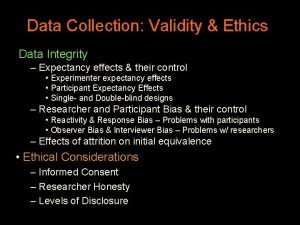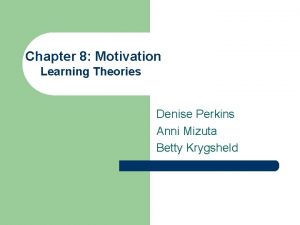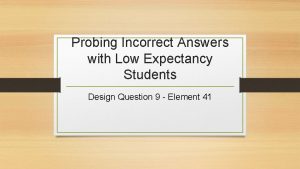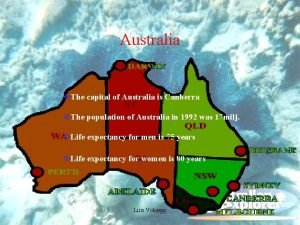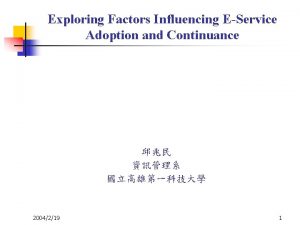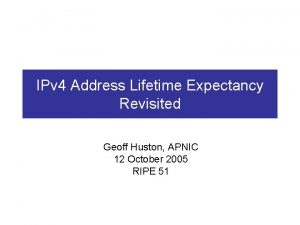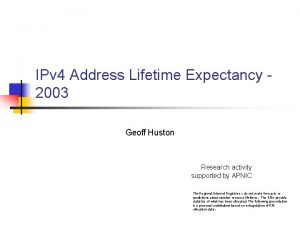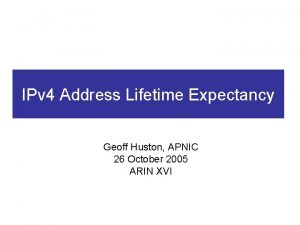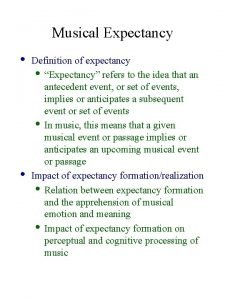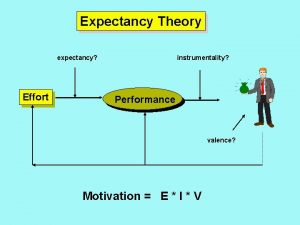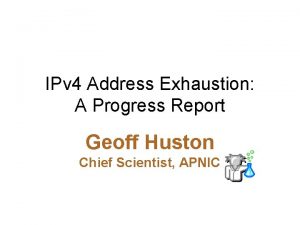IPv 4 Address Lifetime Expectancy Revisited Revisited Geoff






















- Slides: 22

IPv 4 Address Lifetime Expectancy Revisited - Revisited Geoff Huston November 2003 Presentation to the IEPG Research activity supported by APNIC The Regional Internet Registries s do not make forecasts or predictions about number resource lifetimes. The RIRs provide statistics of what has been allocated. The following presentation is a personal contribution based on extrapolation of RIR allocation data.

IPv 4 Address Lifetime Expectancy n n In July the IEPG presentation on address lifetime expectancy used the rate of growth of BGP advertised address space as the overall address consumption driver The presentation analysed the roles of the IANA and the RIRs and created an overall model of address consumption

Modelling the Process – July 2003 IANA Pool Exhaustion 2022 RIR Pool Exhaustion 2024 Projections

Address Consumption Models n n The basic assumption was that continued growth will remain at a constant proportion of the total advertised address space (compound growth), and that as a consequence address exhaustion was predicted to occur sometime around 2025 Does the advertised address data support this view of the address growth model?

The Advertised Address Space

Notes n It’s noisy data n n n There are 3 /8 prefixes that flap on a multi-day cycle There are shorter term flaps of smaller prefixes Reduce the noise by: n n n Removing large steps Applying gradient filter Apply averaging to smooth the data

Smoothed Data (1)

Smoothed Data (2)

Model Matching

But Which Model? n A number of models can be applied to this data: n n n Linear model, assuming a constant rate of growth Polynomial model, assuming a constant rate of change of growth Exponential model, assuming a geometric growth with a constant doubling period

First Order Differential of the data

Linear Best Fit to Differential

Growth Rate n n n The growth rate of 4 – 5 /8 blocks per year in 99 -00 is now appoximately half that, at 2 – 3 /8 blocks per year A constant growth model has a best fit of 3. 5 /8 blocks per year The change in growth over the period is a decline in growth rate by 0. 4 /8 blocks per year

Log of Data

Best Fit to Log

Exponential Model n n n The exponential model assumes a liner best fit to the log of the data series This linear fit is evident across 2000 More recent data shows a negative declining rate in growth of the log of the data.

Projections

Observations n Polynomial best fit sees a continuing decline in growth until growth reaches zero in 2010 n n Exponential best fit sees continuing increase in growth until exhaustion occurs in 2021 n n Matches a model of market saturation Matches a model of uniform continued growth in all parts of the network Linear best fit sees constant growth until exhaustion occurs in 2042 n Matches a model of progressive saturation in existing markets offset by demands in new

Modelling the Process n n n Assume that the RIR efficiency in allocation slowly declines, then the amount of RIR-held space increases over time Assume that the Unannounced space shrinks at the same rate as shown over the past 3 years Assume linear best fit model to the announced address space projections and base RIR and IANA pools from the announced address space projections

Modelling the Process IANA Pool Exhaustion 2030 RIR Pool Exhaustion 2037 Unadvertised Address Pool RIR Holding Pool Projections

Observations n n n Extrapolation of current allocation practices and current demand models using an exponential growth model derived from a 2000 – 2003 data would see RIR IPv 4 space allocations being made for the next 2 decades, with the unallocated draw pool lasting until 2018 - 2020 The use linear growth model sees RIR IPv 4 space allocations being made for the next 3 decades, with the unallocated draw pool lasting until 2030 – 2037 Re-introducing the held unannounced space into the routing system over the coming years would extend this point by a further decade, prolonging the useable lifetime of the unallocated draw pool until 2038 – 2045

Questions n Externalities: n n n What are the underlying growth drivers and how are these best modeled? What forms of disruptive events would alter this model? What would be the extent of the disruption (order of size of the disruptive address demand)?
 Math lesson
Math lesson Zhuoyue zhao
Zhuoyue zhao Memory swaping
Memory swaping Experimenter expectancy effects
Experimenter expectancy effects Xyy male syndrome
Xyy male syndrome Cystic fibrosis life expectancy
Cystic fibrosis life expectancy What are the key tenets of expectancy theory?
What are the key tenets of expectancy theory? Why does a star's life expectancy depend on mass
Why does a star's life expectancy depend on mass Eccles expectancy value theory
Eccles expectancy value theory Color blindness life expectancy
Color blindness life expectancy What is fas
What is fas Signal detection theory example
Signal detection theory example Fetal alcohol syndrome life expectancy
Fetal alcohol syndrome life expectancy Probing incorrect answers with low expectancy students
Probing incorrect answers with low expectancy students Life expectancy in 1500
Life expectancy in 1500 Neural tube
Neural tube Health life expectancy
Health life expectancy Law of reinforcement
Law of reinforcement The expectancy theory
The expectancy theory Life expectancy definiton
Life expectancy definiton Kookaburra life expectancy
Kookaburra life expectancy The expectancy model is developed by -
The expectancy model is developed by - Annual loss expectancy
Annual loss expectancy



